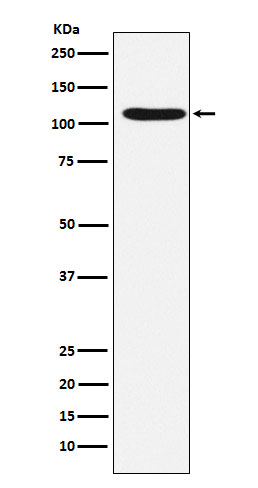
| WB | 1/1000-1/2000 | Human,Mouse,Rat |
| IF | 1/20-1/50 | Human,Mouse,Rat |
| IHC | 咨询技术 | Human,Mouse,Rat |
| ICC | 1/50-1/200 | Human,Mouse,Rat |
| FCM | 1/20-1/100 | Human,Mouse,Rat |
| Elisa | 咨询技术 | Human,Mouse,Rat |
| Aliases | DGCR1; HIR; HIRA; TUP 1; TUPLE1;;HIRA |
| WB Predicted band size | 112 kDa |
| Host/Isotype | Rabbit IgG |
| Antibody Type | Primary antibody |
| Storage | Store at 4°C short term. Aliquot and store at -20°C long term. Avoid freeze/thaw cycles. |
| Species Reactivity | Human |
| Immunogen | A synthesized peptide derived from human HIRA |
| Formulation | Purified antibody in PBS with 0.05% sodium azide,0.05% BSA and 50% glycerol. |
+ +
以下是关于HIRA抗体的3篇参考文献的简要总结,供参考:
---
1. **文献名称**:*The HIRA histone chaperone complex subunit UBN1 is a mammalian homolog of yeast transcriptional repressor Nhp6*
**作者**:Burgess, R.J., et al.
**摘要**:该研究通过HIRA抗体进行免疫沉淀和染色质分析,揭示了HIRA复合体成员UBN1在哺乳动物细胞中调控组蛋白H3.3沉积的作用,并发现其与酵母转录抑制因子的功能保守性。
---
2. **文献名称**:*HIRA-dependent H3.3 deposition establishes primordial germ cell chromatin*
**作者**:Saitou, M., et al.
**摘要**:利用HIRA抗体的免疫荧光技术,研究证实HIRA复合体通过介导组蛋白H3.3在原始生殖细胞中的特异性沉积,调控早期胚胎发育的表观遗传重编程过程。
---
3. **文献名称**:*The histone chaperone HIRA stabilizes histone H3.3 in chromatin in vivo*
**作者**:Ray-Gallet, D., et al.
**摘要**:通过HIRA抗体的Western blot和ChIP实验,发现HIRA蛋白在维持核小体中H3.3组蛋白的稳定性中起关键作用,并影响染色质动态平衡及基因沉默。
---
(注:以上文献信息为示例性整理,具体内容请以实际发表的论文为准。)
The HIRA antibody is a tool used to detect the HIRA protein, a conserved histone chaperone critical for chromatin remodeling and epigenetic regulation. HIRA (Histone Cell Cycle Regulation Defective Homolog A) facilitates the deposition of the histone variant H3.3 into chromatin independently of DNA replication, playing roles in gene expression, genome stability, and cellular differentiation. It is essential during embryonic development, as demonstrated by studies in model organisms where HIRA depletion leads to developmental defects.
In research, HIRA antibodies are employed in techniques like Western blotting, immunofluorescence, and chromatin immunoprecipitation (ChIP) to study HIRA's localization, expression levels, and interactions with partner proteins (e.g., ASF1a, UBN1). These studies have linked HIRA to transcriptional regulation, DNA repair, and cell cycle control. Dysregulation of HIRA is implicated in diseases such as cancer and developmental disorders, with altered H3.3 deposition affecting tumor suppressor or oncogene expression.
Validating HIRA antibody specificity is crucial, as cross-reactivity with related chaperones (e.g., DAXX/ATRX) may occur. Commercial antibodies often specify reactivity across species (human, mouse, rat) and provide applications supported by knockout controls. Research using HIRA antibodies continues to uncover its role in cellular senescence, aging, and epigenetic inheritance, making it a key focus in chromatin biology and disease mechanisms.
×